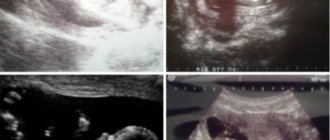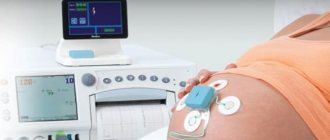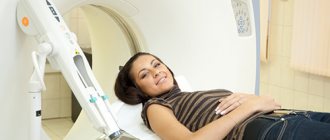Of course, for any expectant mother, pregnancy is a very specific and unusual period in life, during which too many changes occur in a woman’s body to simply not notice. Unfortunately, neither the negative influence of the environment, nor the impact of chronic diseases, nor the possibility of accidentally “catching” the virus can be avoided. During pregnancy, it is highly undesirable to take medications or undergo many medical procedures, as this may affect the development of the fetus. But there are also exceptions.
Why do pregnant women still undergo MRI?
Many types of diagnostics are also contraindicated during pregnancy, but, for example, ultrasound diagnostics (ultrasound) and MRI are carried out quite widely. Why? These diagnostic methods are based on the physical properties of sound waves in media of varying densities (ultrasound) and certain patterns of behavior of hydrogen atoms in a high-power magnetic field. Neither the first nor the second cause significant harm to the human body, which is why they are calmly prescribed by doctors to expectant mothers.
Technique
Before the procedure, a woman must remove all metal objects from her body - rings, earrings, chains, bracelets or crosses. Then the patient lies down on the examination table, which moves into the tomograph tunnel. The examination time is just over half an hour (depending on the number of areas being examined). The device will tap during the entire examination. These sounds sometimes cause psychological discomfort. If you feel a deterioration in your health, click on a special call. Keep in mind that you cannot move during the procedure, so it is better to immediately take the most comfortable position.
MRI of the brain during pregnancy
The peculiarity of this type of diagnosis is that the patient does not have to be completely immersed in the tunnel, since it is possible to use an open tomograph that covers only the head. MRI of the head
during pregnancy, it allows you to diagnose various neoplasms in the brain, monitor the condition of blood vessels, and promptly learn about the presence of an aneurysm.
MRI of the cervical spine during pregnancy
In the same way as the previous type of study, it can be carried out on an open-type device. During the procedure, the vessels of the cervical spine are examined. Based on the result obtained, the doctor can talk about cerebral circulatory insufficiency, the size of the lymph nodes, etc.
MRI of the fetus during pregnancy
Diagnostics are carried out only in a closed-type tomograph. The magnetic field affects the pelvic area. An MRI of the pelvis can be done during routine pregnancy monitoring instead of a classic ultrasound.
Are there any exceptional cases for MRI during pregnancy?
There are exceptions to this rule. If there is a threat to the life of the mother, doctors are given the right to use all available types of medical diagnostics without restrictions.
What are the contraindications for MRI?
MRI is prohibited for pregnant women and in other cases:
- if there are foreign metal bodies in the patient’s body:
- if you have a pacemaker, automatic insulin pump or other implanted electronic devices;
- in the presence of knitting needles, fixing screws or plates on the bones, as well as in the presence of endoprostheses (the composition must be clarified).
QUALITY MRI EXAMINATION
MRI during pregnancy is performed to diagnose both mother and fetus. Fetal MRI provides data that is 55% more accurate than ultrasound data. The information obtained makes it possible to correctly assess the characteristics of the current pregnancy. MRI is more sensitive than ultrasound in detecting defects present in the development of the fetus. This procedure allows you to determine fetal pathologies, whether there are neoplasms and what their location is, you can determine the functioning of the central nervous system and intestines, determine the presence of a hernia, and much more.
It is advisable to make MRI a habit
A lady consulted a gynecologist with complaints about the appearance of bloody, pink discharge from the genital tract. Her cheerfulness and youthful appearance beyond her years did not foretell any unpleasant surprises.
An ultrasound of the pelvic organs revealed a polyp in the uterine cavity. In order to clarify the diagnosis, the gynecologist referred the patient for an MRI, where complete destruction of the muscle tissue of the uterus was visualized.
Apparently, the process lasted two to three years; in fact, we are talking about the second or third stages of cancer. The patient was referred to an oncologist.
Neither ultrasound nor external examination made it possible to timely determine the presence of malignant tumors. MRI allows you to detect malignant and benign formations at the earliest stages, when their size does not exceed 0.5 mm. With ultrasound, the lower limit of accuracy is about 1 cm, but this is subject to the highly qualified doctor and the resolution of the equipment. It must be of an expert class. That is why it is very important to conduct MRI not only as prescribed by the attending physician, but also for preventive purposes. For example, during medical examinations.
Is breastfeeding possible after an MRI with contrast?
MRI of the head with contrast can be performed on women during lactation; the only risk that arises in this case is the risk of the child developing an allergy to the substances contained in it (an allergy to contrast is also observed in adults).
Contrast circulates throughout all body fluids, and breast milk is no exception. To prevent allergic reactions, before doing an MRI with contrast, you need to take care of the baby's nutrition for the next 24-48 hours (pumping or formula).
IN WHAT CASES IS IT BETTER TO DO AN MRI THAN AN ULTRASOUND?
In many cases, it is possible to examine the fetus and diagnose pathologies using ultrasound. But if there are factors that prevent this procedure from being done correctly, then the MRI method is preferable.
Such cases include: Problems with the integrity of the amniotic bladder Problems with the placenta Oligohydramnios or polyhydramnios Maternal obesity Poor fetal position
If the question is which is better than MRI or ultrasound, then decide for yourself, but remember that ultrasound provides only general information about the development of the fetus, and MRI makes it possible to see the structure of the internal organs of the fetus and evaluate their functioning. This procedure is most often prescribed as an additional examination to ultrasound to obtain more accurate information.
Why do the eyes bleed and the baby that matured in... the ovary
There are many examples where magnetic resonance imaging (MRI) made it possible to identify hidden pathologies or, on the contrary, to refute a previously made diagnosis and avoid unnecessary surgery.
By the way, the latter is also very relevant, especially against the backdrop of increasing cases of surgical aggression towards patients. You can find many sites on the Internet that talk about MRI as an advanced and very effective diagnostic method. But we decided to start with examples that actually took place, which the gynecologist at the Medservice clinic told us about.
Contraindications
In the first trimester, they try not to prescribe the MR procedure or do it with great caution. There are several reasons for this:
- In the early stages, the laying and formation of all the vital organs of the child occurs. It is important for the expectant mother to protect the baby from the influence of aggressive environmental factors and not subject the body to additional stress, such as increased noise levels and increased temperature. During an MR session, the unit produces a monotonous sound and produces a lot of heat.
- Even if we assume the possibility of performing tomography in the initial stages, there is a high probability that the resulting images will not be able to help in diagnosis. This is explained by the fact that the fetus is still too small and very mobile; it is not able to fix its position for a long time.
- An unconditional contraindication for the procedure is the presence in the human body of foreign objects made of metal (implants, dental crowns, fragments) or electronic devices (pacemakers). The procedure will also be questionable if you have tattoos with metallic inclusions.
- If you have a strong fear of closed spaces, you should not undergo a session in a closed type installation. It is better to choose a medical institution that uses open-type devices with air gaps; in this case, claustrophobia will no longer be a contraindication.
- Epilepsy and mental disorders will become an obstacle to the session, since there is a high probability that the patient will not be able to remain in an immobilized state throughout the entire process.
- There is also a contraindication for weight up to two hundred kilograms. Tomographs are simply not manufactured to exceed this weight. When making an appointment at a clinic, check what the maximum weight is for the MR unit at that institution.
When is research not recommended?
Contraindications to research during pregnancy do not differ in any way from those for all people:
- pacemakers;
- surgical staples;
- middle ear implants;
- kidney pathologies that make it difficult to remove contrast;
- excess weight exceeding the load capacity of the tomograph.
You should consult your doctor if you have prosthetic heart valves, insulin pumps, paramagnetic middle ear implants, or inner ear prostheses.
Reviews
09/02/2018 A very good RIORIT center near the Ozerki metro station, I recommend it to everyone from the bottom of my heart.
I had already had an X-ray before them, and they sent me for an ultrasound, but none of the doctors could tell me what kind of illness I had, and the treatment didn’t help. I understand that MRI diagnostics are so wonderful, but I also want to say thank you to the medical staff. Because the cost was small, they gave me a discount and scheduled me for a time that was convenient for me. And their atmosphere is very friendly, and most importantly, everyone clearly explained what to do, how to prepare, everything was outlined point by point. I didn’t wait a single extra minute. Good service, you wouldn’t even think that the center is inexpensive. Thank you. Lebyazhina
02/09/2018 We sincerely thank the entire team of the RIORIT MRI center for their prompt and organized attitude towards us.
Thank you very much for your sensitive, friendly and attentive, serious attitude. We wish you success. Be healthy! 02/09/2018 Tikhomirova V. I
07/16/2017 We learned about the RIORIT center via the Internet, we were very pleased with the prices and service!!!
Thank you!!! Patient
Read all reviews
What is MR pelviometry and MR fetometry
MR fetometry and MR pelviometry are special scanning programs for pregnant women and the fetus, which allow gynecologists to answer several important questions in one study: the presence and degree of pelvic narrowing in a pregnant woman, the presence of a risk of disproportion between the pelvis and the fetal head, as well as high accurately predict the weight of the full-term fetus, which allows obstetricians to promptly choose the optimal method of delivery. The main indications for MR pelviometry are:
- Suspicion of a narrow pelvis if the woman’s height is less than 160 cm;
- Suspicion of disproportion between the maternal pelvis and the fetal head (large fetus > 4000 g).
- Suspicion of anatomical changes in the pelvis - a history of pelvic trauma, rickets and poliomyelitis, congenital dislocation of the hip joints, divergence of the symphysis pubis.
- Breech presentation.
- The presence of a scar on the uterus after a cesarean section.
Types of diagnostics and whether they are safe during pregnancy
The most common research methods during pregnancy are:
- Radiography
- Ultrasound
- MRI
Most often, with a favorable course of pregnancy, it is enough to only conduct an ultrasound scan at different periods of the pregnancy. X-rays and computed tomography can be dangerous for a woman’s health and the development of a child; the diagnostic capabilities of these methods are limited.
Numerous studies confirm that the MRI method is completely safe and, if the recommendations are followed, diagnostics can be carried out even in the first months of pregnancy.
| X-ray | A directed beam of electromagnetic waves is used, which is dangerous for the fetus. |
| Ultrasound | Studies are carried out under the influence of ultrasonic waves; this method is not dangerous, but provides little information on pathology. |
| CT | The study uses ionizing radiation, which can be harmful for pregnant women. |
| MRI | The influence of a magnetic field on a person is used, a safe and informative method. |








